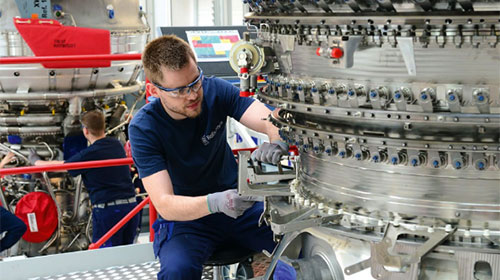Berlin Aerospace Center
The aerospace industry is one of the capital region's most important future industries. It combines a high level of innovation with sophisticated technology.
The capital region ranks among the three most important locations for aerospace technology in Germany. With global players such as Planet Labs, Rolls-Royce and MTU, world-renowned aerospace companies are in the region. In their environment there are many opportunities for small and medium-sized enterprises as suppliers or in the service, security, or IT sectors. They all benefit from exceptionally high scientific and research potential in the capital region.
Facts and figures
- About 7,500 specialists, technicians and engineers work for aerospace companies in the capital region
- Approximately 17,000 employees work in the aviation industry
- Venue of the Innovation and Leadership in Aerospace Berlin (ILA), the third largest trade fair in the world in this segment, and one of the highest-selling
- Optimal networking in and with the regional aerospace industry via the Berlin-Brandenburg Aerospace Alliance (BBAA)
- Regional core competencies of the companies in satellite technologies, propulsion technology, maintenance, overhaul and repair (aircraft maintenance), simulation, testing, engineering and software development as well as the design of urban airspace (UAM)
Competence Center for Aerospace Technologies and New Space
Traditionally, the regional aerospace sector has been characterized by the small satellite segment. Three players in the region produce complete small satellites: Astro- und Feinwerktechnik Adlershof GmbH, Berlin Space Technologies, and TU Berlin. TU Berlin is the university with the most satellites in orbit worldwide.
A growing number of start-ups in Berlin are working on "New Space." In 2021, for example, the Berlin-based start-up LiveEO GmbH used satellite data to analyse the entire US electricity grid of more than 7 million miles for the first time.
More than 70 companies, training institutes (e.g. beSpace GmbH), and research centers (e.g. DLR, HU Berlin, Ferdinand Braun Institut), which are anchored in the capital region, are pursuing space and with their various expertise and specializations, form a holistic, interdisciplinary, regional center of competence for aerospace technologies and applications.
Regional drone technologies are conquering the market
Civil unmanned aerial systems have recently been added to the established activities. Here there is great deal of momentum in terms of applications and services. More than 60 players from the field of research (e.g. DAI Labor, the European Aviation Security Center), development (e.g. germandrones GmbH, Multirotor Beteiligungsgesellschaft mbH, BärDrones), and application (e.g. Airteam) are helping to make the capital region a leading unmanned flying location. Urban airspace is being utilised by model projects such as the transport of laboratory samples and medicines on the premises of the Berlin Charité.
Selected aerospace companies and research institutions
- Lufthansa Technik Logistik GmbH Berlin-Schönefeld
- PACE Aerospace Engineering and Information Technology GmbH
- Technische Universität TU Berlin
- Deutsches Zentrum für Luft- und Raumfahrt
- MTU Maintenance Berlin-Brandenburg GmbH Ludwigsfelde
- Rolls-Royce Deutschland Ltd. & CoKg Dahlewitz
- Astro- und Feinwerktechnik Adlershof GmbH
- AneCom AeroTest GmbH Wildau
- European Aviation Security Center e.V. Schönhagen
- LiveEO GmbH
- Berliner Glas GmbH
- FTI Group
- AQUILA Aviation GmbH
- Magson GmbH
Networks, initiatives and associations
BBAA
Berlin-Brandenburg Aerospace Alliance (BBAA e. V.): A strong aerospace network in the region
Regionally, the industry network BBAA is working together with cluster management to further strengthen the region's ties to the aerospace industry. BBAA coordinates and supports established R&D collaborations, especially in the fields of energy-efficient aviation, digital solutions in the aerospace industry, and New Space.
DRONEMASTERS
DroneMasters Boost GmbH is a Berlin-based incubator for drone-related companies. They network, advise, and provide support for any business working on drones. As a strategic investor, they participate in start-ups that have dedicated themselves to driving the future of automated aerial mobility. They also host numerous events in a variety of formats: DRONEMASTERS Meetup, DRONEMASTERS Convention, DRONEMASTERS Summit, and DRONEMASTERS Mobility Conference which provide the basis for knowledge sharing and technology transfer at regional, national, and international levels.
CURPAS e. V. (Civil Use of Remotely Piloted Aircraft Systems)
CURPAS is a network of companies and research institutions mainly located in the Berlin-Brandenburg region that are working on applications and further development of innovative unmanned systems.
EASC e. V. (European Aviation Security Center)
EASC is an independent research center for aviation security in Europe.
It was founded in May 2008 as a non-profit association with the aim of supporting companies, research institutes, universities, and public authorities.
- It promotes research and development for the long-term technical and organisational guarantee of aviation security in European and international aviation. It also examines the societal implications of security technology and processes
- and plans to create a research and validation center specializing in aviation security at Schönhagen airfield.
- It will also create an interface among aviation security stakeholders and create a neutral platform for the exchange of knowledge and ideas.





